Marc Tyler Nobleman's Blog, page 63
July 19, 2015
The bigness of Batman, in short
Batman’s adventures were larger than life, literally.
On comic book covers in the 1940s and early 1950s, his villains were sometimes shown as giants.
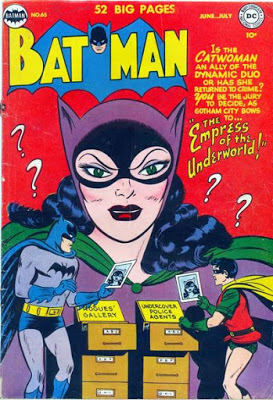
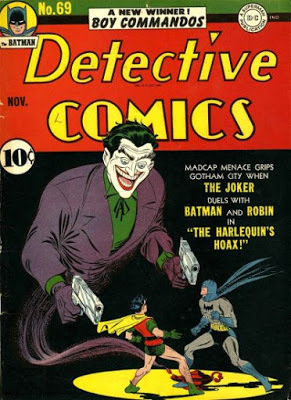
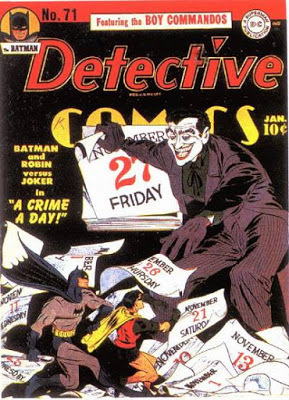
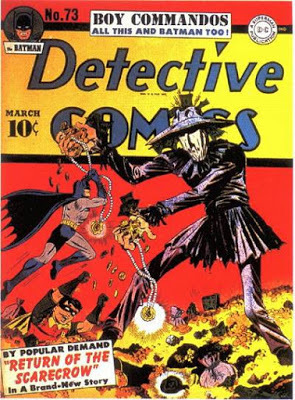
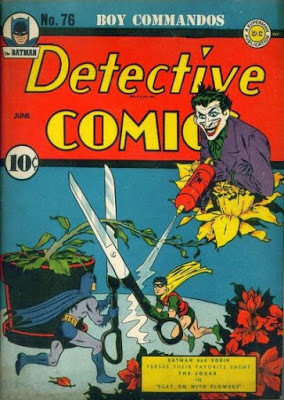
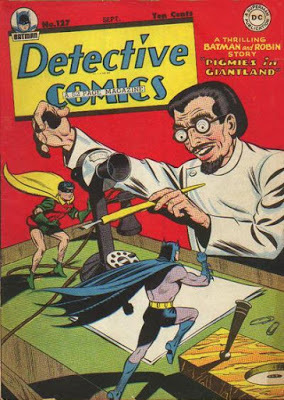 This time, it was literal.
This time, it was literal.
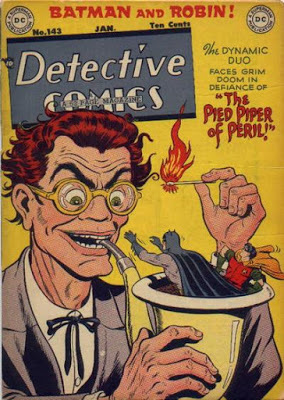
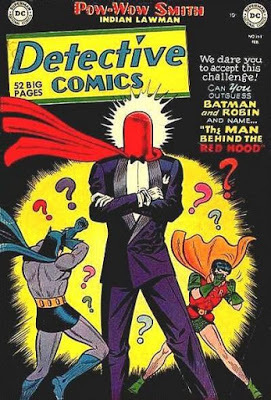
Inside, he fought those villains on oversized props.
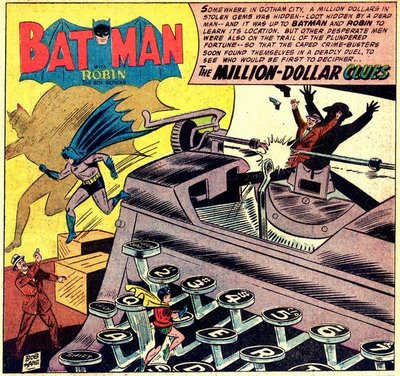
Even his ears were bigger (sometimes extremely so).
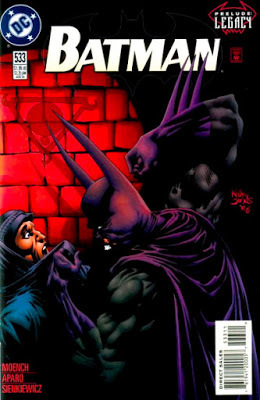
Bats may be small but Batman has never been.
On comic book covers in the 1940s and early 1950s, his villains were sometimes shown as giants.





 This time, it was literal.
This time, it was literal.

Inside, he fought those villains on oversized props.

Even his ears were bigger (sometimes extremely so).

Bats may be small but Batman has never been.
Published on July 19, 2015 04:00
July 15, 2015
Super-Team Family: The Lost Issues blog
Superheroes are already fantasy, but why stop there?
As a kid, I was, no surprise, the biggest Super Friends fan going. One of the show’s hallmarks (like the Justice League comics that inspired it) was the way in which the larger assembly of heroes would divide into smaller groups to tackle simultaneous crises. I loved seeing who went with who each time, and made up my own mental wish-list sub-groupings.
Today, I still love this about the medium—and its inventive derivations.
My first online stop of the day is Super-Team Family: The Lost Issues, a daily dose of fictional meetings of fictional characters (as opposed to the “real” meetings of fictional characters that play out in comics, movies, and TV shows).
A labor of love by Ross Pearsall, it combines characters who (usually) haven’t co-starred in an actual published story. Ross doesn’t limit himself to superheroes; his covers also tap popular figures from science fiction, action-adventure, comic strips, rock music, and more.
Many of the pairings are inspired (Dr. Mid-Nite and Moon Knight) and sometimes batsplat crazy (Vibe joins the Monkees). The digital mojo on display is seamless, plus Ross has a gift for clever wordplay; the titles of his fake stories are spot-on.
Ross may rue the day I discovered his work because I regularly send him unsolicited suggestions. A guy who teamed up Huntress and Darkman and Godzilla and Boba Fett and Peanuts and Tiny Titans is obviously is not lacking for inspiration.
Still, he humors me, and sometimes even runs with one of my suggestions. (Sometimes it turns out that he beat me to it—either a team-up that was already up but I missed or one already in the works. Geek minds think alike.)
Ideas I proposed:
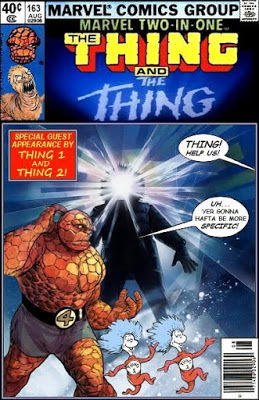 The Thing and Thing 1 and Thing 2 (though the main co-star is the other Thing)
The Thing and Thing 1 and Thing 2 (though the main co-star is the other Thing)
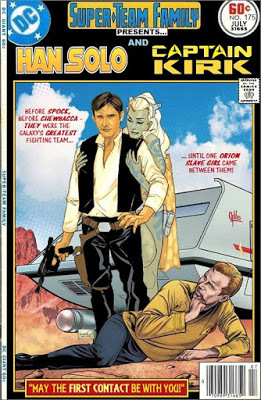 James Kirk and Han Solo (both space captains)
James Kirk and Han Solo (both space captains)
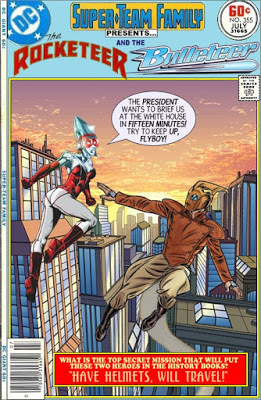 Rocketeer and Bulleteer
Rocketeer and Bulleteer
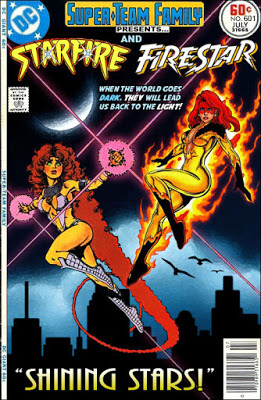 Firestar and Starfire
Firestar and Starfire
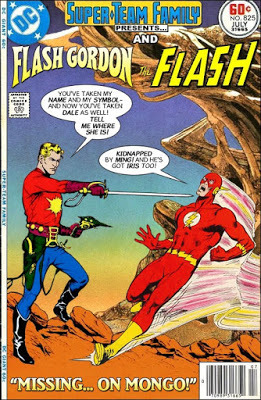 Flash Gordon and Flash
Flash Gordon and Flash
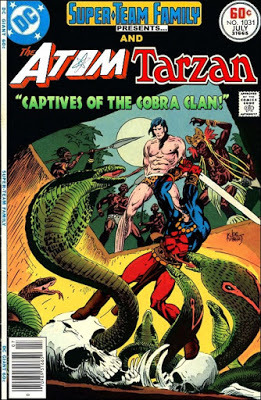 Tarzan and Atom (namely Sword of the Atom)
Tarzan and Atom (namely Sword of the Atom)
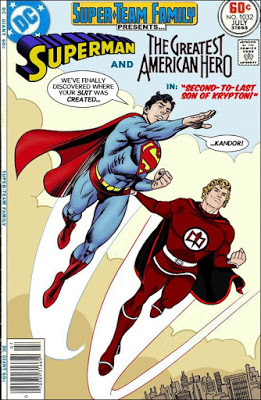 Superman and Greatest American Hero
Superman and Greatest American Hero
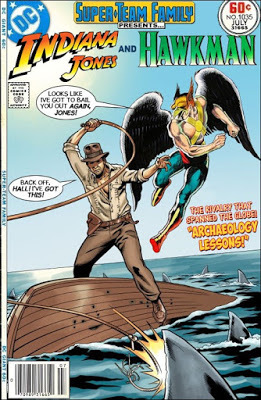 Hawkman and Indiana Jones (both archeologists)
Hawkman and Indiana Jones (both archeologists)
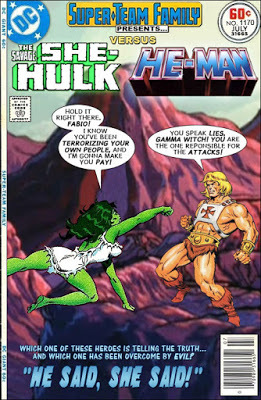 She-Hulk and He-Man(hers and his hyphenates)
She-Hulk and He-Man(hers and his hyphenates)
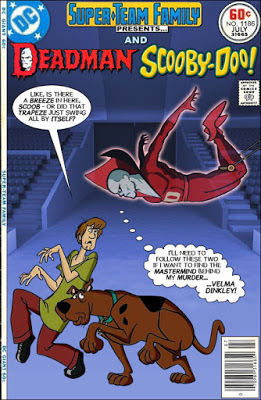
Scooby-Doo and Deadman
All work copyright its respective original creators. All team-up alchemy credit to Ross. Keep it going, Ross!
As a kid, I was, no surprise, the biggest Super Friends fan going. One of the show’s hallmarks (like the Justice League comics that inspired it) was the way in which the larger assembly of heroes would divide into smaller groups to tackle simultaneous crises. I loved seeing who went with who each time, and made up my own mental wish-list sub-groupings.
Today, I still love this about the medium—and its inventive derivations.
My first online stop of the day is Super-Team Family: The Lost Issues, a daily dose of fictional meetings of fictional characters (as opposed to the “real” meetings of fictional characters that play out in comics, movies, and TV shows).
A labor of love by Ross Pearsall, it combines characters who (usually) haven’t co-starred in an actual published story. Ross doesn’t limit himself to superheroes; his covers also tap popular figures from science fiction, action-adventure, comic strips, rock music, and more.
Many of the pairings are inspired (Dr. Mid-Nite and Moon Knight) and sometimes batsplat crazy (Vibe joins the Monkees). The digital mojo on display is seamless, plus Ross has a gift for clever wordplay; the titles of his fake stories are spot-on.
Ross may rue the day I discovered his work because I regularly send him unsolicited suggestions. A guy who teamed up Huntress and Darkman and Godzilla and Boba Fett and Peanuts and Tiny Titans is obviously is not lacking for inspiration.
Still, he humors me, and sometimes even runs with one of my suggestions. (Sometimes it turns out that he beat me to it—either a team-up that was already up but I missed or one already in the works. Geek minds think alike.)
Ideas I proposed:
 The Thing and Thing 1 and Thing 2 (though the main co-star is the other Thing)
The Thing and Thing 1 and Thing 2 (though the main co-star is the other Thing) James Kirk and Han Solo (both space captains)
James Kirk and Han Solo (both space captains) Rocketeer and Bulleteer
Rocketeer and Bulleteer Firestar and Starfire
Firestar and Starfire Flash Gordon and Flash
Flash Gordon and Flash Tarzan and Atom (namely Sword of the Atom)
Tarzan and Atom (namely Sword of the Atom)
 Superman and Greatest American Hero
Superman and Greatest American Hero Hawkman and Indiana Jones (both archeologists)
Hawkman and Indiana Jones (both archeologists) She-Hulk and He-Man(hers and his hyphenates)
She-Hulk and He-Man(hers and his hyphenates)
Scooby-Doo and Deadman
All work copyright its respective original creators. All team-up alchemy credit to Ross. Keep it going, Ross!
Published on July 15, 2015 04:00
July 13, 2015
Bill Finger in “amNY,” a free daily newspaper
Cristian Salazar at amNewYork contacted me with questions about the connection between the Grand Concourse and the creation of Batman. This led to a nice mention of Bill the Boy Wonder: The Secret Co-Creator of Batman in a 7/7/15 article about the storied history of this major Bronx thoroughfare.
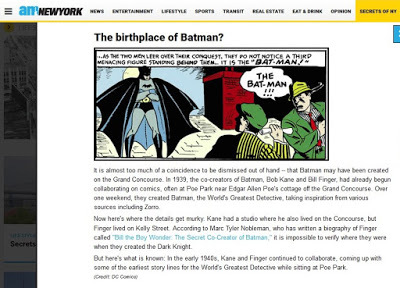
My theory is that Bill Finger and Bob Kane were not on the GC when they created Batman, but weren’t far. And they were there—specifically Poe Park, at 2640 Grand Concourse—to brainstorm later Batman stories.

My theory is that Bill Finger and Bob Kane were not on the GC when they created Batman, but weren’t far. And they were there—specifically Poe Park, at 2640 Grand Concourse—to brainstorm later Batman stories.
Published on July 13, 2015 04:00
July 11, 2015
Jay Emmett, negotiated Siegel and Shuster’s Superman settlement, 1928-2015
Twice in a two-week period, I was too late.
My list of pop culture figures to track down and interview was reduced by two with the deaths of actress Amanda Peterson and former Warner Communications (now Time Warner) executive Jay Emmett, who passed on 6/22/15. (Yes, this is the world’s only post that mentions both of them.)
I’ve already quoted Jay here (in 2014), and that quotation is worth reposting at any time, not just in light of the circumstances. In 1975, when Jay was Executive VP of Warner Communications, he said of Jerry Siegel and Joe Shuster: “Legally, nothing has to be done. Morally, I think something should be done, and we will do it out of compassion.”
And they did. And ever since, fans have debated how fair the settlement was. In one of my earliest blog posts, I sketched out ways (according to me) in which Jerry Siegel and Joe Shuster were “right” and “wrong” and the ways in which the company that is now DC Entertainment was “right” and “wrong.”
When I quoted Jay last year, I also asked out loud where he had gone. Then I immediately tried to answer my own question, surprised that it took me that long to think to do so. Thanks to fellow Superman author Larry Tye, I did reach out to Jay with an interview request, but did not hear back. I followed up, but again, no reply. I now know that he was not well of late, though perhaps he would not have responded in any case; another Superman author/friend, Brad Ricca, said it’s possible Jay was bound by a NDA.
Whatever you think of the Siegel and Shuster settlement, it was something—far more than Bill Finger got. If you’re a Superman fan, you owe Jay a debt of gratitude. Apparently he was a heckuva guy in his own right.
My list of pop culture figures to track down and interview was reduced by two with the deaths of actress Amanda Peterson and former Warner Communications (now Time Warner) executive Jay Emmett, who passed on 6/22/15. (Yes, this is the world’s only post that mentions both of them.)
I’ve already quoted Jay here (in 2014), and that quotation is worth reposting at any time, not just in light of the circumstances. In 1975, when Jay was Executive VP of Warner Communications, he said of Jerry Siegel and Joe Shuster: “Legally, nothing has to be done. Morally, I think something should be done, and we will do it out of compassion.”
And they did. And ever since, fans have debated how fair the settlement was. In one of my earliest blog posts, I sketched out ways (according to me) in which Jerry Siegel and Joe Shuster were “right” and “wrong” and the ways in which the company that is now DC Entertainment was “right” and “wrong.”
When I quoted Jay last year, I also asked out loud where he had gone. Then I immediately tried to answer my own question, surprised that it took me that long to think to do so. Thanks to fellow Superman author Larry Tye, I did reach out to Jay with an interview request, but did not hear back. I followed up, but again, no reply. I now know that he was not well of late, though perhaps he would not have responded in any case; another Superman author/friend, Brad Ricca, said it’s possible Jay was bound by a NDA.
Whatever you think of the Siegel and Shuster settlement, it was something—far more than Bill Finger got. If you’re a Superman fan, you owe Jay a debt of gratitude. Apparently he was a heckuva guy in his own right.
Published on July 11, 2015 04:00
July 10, 2015
Amanda Peterson of “Can’t Buy Me Love,” 1971-2015
Like many people my age, I saw Can’t Buy Me Love in 1987 and then an untold number of additional times on cable. I even bought the DVD probably five or six years ago, though I did not watch it till this week when news broke that its female lead, Amanda Peterson, died at age almost-44.
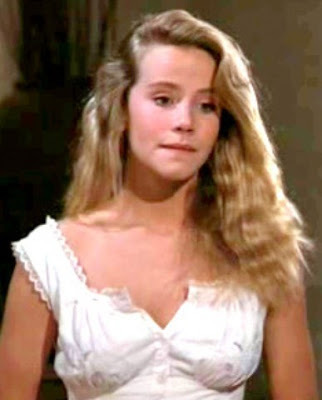
In my self-appointed role of “pop culture archeologist,” I keep a list of people I want to track down and interview, and Amanda was on that list. Her last appearance in a film was in 1994. Over the years, I’ve seen more than a couple of posts by people asking whatever happened to her.
Now we know she had rough patches. This is always upsetting to learn, but in this case more so because she seemed to fall victim to some of the traps she presumably left Hollywood to avoid.
Upon rewatching CBML for the first time in more than 20 years, I felt it hasn’t aged particularly well. But Cindy, the character Amanda played, is the least clichéd part of it. Her performance is charming and assured.
The world learned of Amanda’s death on 7/6/15, and the morning after, I contacted Ryan Hartsock, the Colorado photographer who took the last known professional photos of Amanda, in 2012. They’d been online since then, apparently, but didn’t come up when I searched for Amanda a year or so ago.
 photos courtesy of Ryan Hartsock of KR Productions/Twisted Pixels Photography
photos courtesy of Ryan Hartsock of KR Productions/Twisted Pixels Photography
Unsurprisingly, at least one outlet much larger than me also interviewed Ryan, and beat me to posting it. But I am running mine anyway, as a tribute to the star of a movie that meant enough to me at one point that I wanted to own it. Thank you for your time, Ryan. If you were suffering, Amanda, I’m glad you aren’t anymore.
How is it that you met Amanda?
I met Amanda through a friend while planning an event to help models and photographers in May 2012.
Did you meet her family, too?
I never had the opportunity of meeting her family other than her daughter.
What was her initial response when you asked to photograph her?
We spent quite a bit of time on the phone leading up to the event and never once mentioned taking her photo. On June 3, 2012, she and I talked and it was decided that she was willing to shoot on the conditions that she choose the photos and “don’t Photoshop the hell out of me.” The images I took that day were only released at her discretion and on her time frame. She was very careful as to how they were released.
The snake...was she immediately cool to pose with that? Or nervous?
She loved the snake, as did her daughter. She spent a great deal of time playing with it and I think had a genuinely good time.
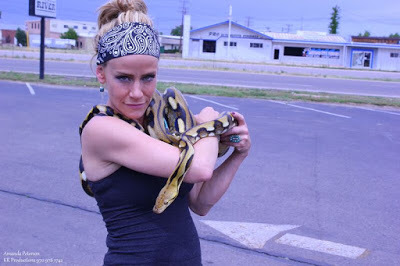
Why did you photograph her? How aware were you of her movie past?
She wanted to get back in front of the camera on her own terms and I accepted. I jokingly say it took convincing but in reality, although she was hesitant because it had been so long, she was totally open to the idea. I knew of her role in movies but to date I still haven’t seen them, other than Annie when I was young.
Updates on Amanda were virtually nonexistent online, but apparently you’d posted the photos back in 2012? Before she died, did anyone stumble upon them and ask you about her?
We had agreed to post the pics and just see the response without advertising the shoot. People were able to send emails through the website that she and I would read when we were able to meet up. She didn’t have her own email so she would sit with my computer and read through the fan mail that had been sent to me. That always brightened her day. There have been several people that have been in contact over the years with various interview offers and requests but she wasn’t ready and had hopes of starting her own blog and website that unfortunately we never finished.
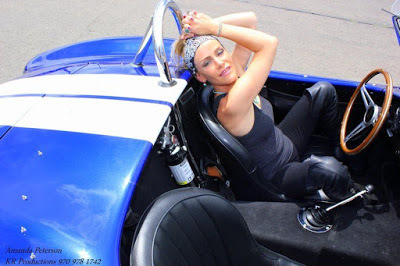
Did you ask why she left the film business and/or if she had plans to try to break back in?
No, it was kind of a non-issue. I base my opinions of people on the present and how they treat me and those around them. I was there to listen to various stories as she brought them up but her past to me is irrelevant, she was a great person while I knew her and that’s what matters.
Did you see/communicate with her after the impromptu shoot?
We did stay in contact every few months over the years but it definitely wasn’t all the time. We would go months without any contact and then spend hours at Starbucks while she read the latest gossip about herself or spend time texting back and forth regarding offers or ideas. I was a go-between basically, I would send her the info and she would go over things with her manager and get back with a yes or no. She was cautious to keep her whereabouts as private as possible.
Anything else about Amanda you’d like to add?
I would love to get all of the photos from that day to her family but the only number I have is her cell. If they could contact me, that would be great. [MTN: They since have.] She had an effect on so many people and I think it would be nice to get all these emails and messages to them so they can see the good versus all the media spin and gossip that seems to flood the headlines. She was a great individual and it’s disheartening to see how cruel people can be. She had also sent me cell phone pics of her and some of her friends backstage at concerts, etc. Although she wanted them to be seen, I don’t feel that this is the time now and I’d like to pass them off to her family.
In the time I knew Mandy, she always treated me with kindness and respect. Although I was just breaking out in photography at the time, I’ll always feel honored that of all the great photographers she could work with she chose lil ol’ me.


In my self-appointed role of “pop culture archeologist,” I keep a list of people I want to track down and interview, and Amanda was on that list. Her last appearance in a film was in 1994. Over the years, I’ve seen more than a couple of posts by people asking whatever happened to her.
Now we know she had rough patches. This is always upsetting to learn, but in this case more so because she seemed to fall victim to some of the traps she presumably left Hollywood to avoid.
Upon rewatching CBML for the first time in more than 20 years, I felt it hasn’t aged particularly well. But Cindy, the character Amanda played, is the least clichéd part of it. Her performance is charming and assured.
The world learned of Amanda’s death on 7/6/15, and the morning after, I contacted Ryan Hartsock, the Colorado photographer who took the last known professional photos of Amanda, in 2012. They’d been online since then, apparently, but didn’t come up when I searched for Amanda a year or so ago.
 photos courtesy of Ryan Hartsock of KR Productions/Twisted Pixels Photography
photos courtesy of Ryan Hartsock of KR Productions/Twisted Pixels PhotographyUnsurprisingly, at least one outlet much larger than me also interviewed Ryan, and beat me to posting it. But I am running mine anyway, as a tribute to the star of a movie that meant enough to me at one point that I wanted to own it. Thank you for your time, Ryan. If you were suffering, Amanda, I’m glad you aren’t anymore.
How is it that you met Amanda?
I met Amanda through a friend while planning an event to help models and photographers in May 2012.
Did you meet her family, too?
I never had the opportunity of meeting her family other than her daughter.
What was her initial response when you asked to photograph her?
We spent quite a bit of time on the phone leading up to the event and never once mentioned taking her photo. On June 3, 2012, she and I talked and it was decided that she was willing to shoot on the conditions that she choose the photos and “don’t Photoshop the hell out of me.” The images I took that day were only released at her discretion and on her time frame. She was very careful as to how they were released.
The snake...was she immediately cool to pose with that? Or nervous?
She loved the snake, as did her daughter. She spent a great deal of time playing with it and I think had a genuinely good time.

Why did you photograph her? How aware were you of her movie past?
She wanted to get back in front of the camera on her own terms and I accepted. I jokingly say it took convincing but in reality, although she was hesitant because it had been so long, she was totally open to the idea. I knew of her role in movies but to date I still haven’t seen them, other than Annie when I was young.
Updates on Amanda were virtually nonexistent online, but apparently you’d posted the photos back in 2012? Before she died, did anyone stumble upon them and ask you about her?
We had agreed to post the pics and just see the response without advertising the shoot. People were able to send emails through the website that she and I would read when we were able to meet up. She didn’t have her own email so she would sit with my computer and read through the fan mail that had been sent to me. That always brightened her day. There have been several people that have been in contact over the years with various interview offers and requests but she wasn’t ready and had hopes of starting her own blog and website that unfortunately we never finished.

Did you ask why she left the film business and/or if she had plans to try to break back in?
No, it was kind of a non-issue. I base my opinions of people on the present and how they treat me and those around them. I was there to listen to various stories as she brought them up but her past to me is irrelevant, she was a great person while I knew her and that’s what matters.
Did you see/communicate with her after the impromptu shoot?
We did stay in contact every few months over the years but it definitely wasn’t all the time. We would go months without any contact and then spend hours at Starbucks while she read the latest gossip about herself or spend time texting back and forth regarding offers or ideas. I was a go-between basically, I would send her the info and she would go over things with her manager and get back with a yes or no. She was cautious to keep her whereabouts as private as possible.
Anything else about Amanda you’d like to add?
I would love to get all of the photos from that day to her family but the only number I have is her cell. If they could contact me, that would be great. [MTN: They since have.] She had an effect on so many people and I think it would be nice to get all these emails and messages to them so they can see the good versus all the media spin and gossip that seems to flood the headlines. She was a great individual and it’s disheartening to see how cruel people can be. She had also sent me cell phone pics of her and some of her friends backstage at concerts, etc. Although she wanted them to be seen, I don’t feel that this is the time now and I’d like to pass them off to her family.
In the time I knew Mandy, she always treated me with kindness and respect. Although I was just breaking out in photography at the time, I’ll always feel honored that of all the great photographers she could work with she chose lil ol’ me.

Published on July 10, 2015 09:13
“Boys of Steel” on NYPL summer reading list
With the summer reading theme “Every Hero Has a Story” in full swing, I was honored to hear that Boys of Steel: The Creators of Superman made the summer reading list (nonfiction, grades 2-3) of the New York, Brooklyn, and Queens Public Libaries.
I was bummed Bill the Boy Wonder: The Secret Co-Creator of Batman didn’t, especially since it’s a New York story. However, as Betsy Bird kindly explained, only paperbacks are eligible. (They didn’t know about this.)
I suppose you could say both books are New York stories. Metropolis and Gotham, the fictional cities of Superman and Batman, respectively, are both analogs for New York (some say Metropolis is New York during the day, Gotham is New York at night).
Semantics aside, thank you, NYPL!

I was bummed Bill the Boy Wonder: The Secret Co-Creator of Batman didn’t, especially since it’s a New York story. However, as Betsy Bird kindly explained, only paperbacks are eligible. (They didn’t know about this.)
I suppose you could say both books are New York stories. Metropolis and Gotham, the fictional cities of Superman and Batman, respectively, are both analogs for New York (some say Metropolis is New York during the day, Gotham is New York at night).
Semantics aside, thank you, NYPL!

Published on July 10, 2015 04:00
July 8, 2015
“Bill the Boy Wonder,” Scholastic Book Club edition: “I cried”
In 2013, Scholastic produced a Book Club (paperback) edition of Bill the Boy Wonder: The Secret Co-Creator of Batman, which I’ve previously mentioned only in passing (in 11/13). I guess this mention is not much more than in passing, either. But at least now I give a link.
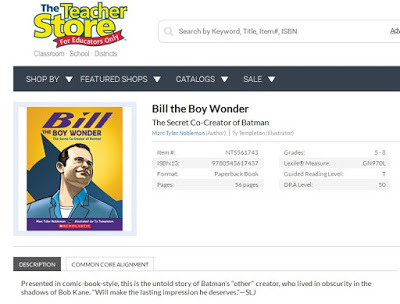
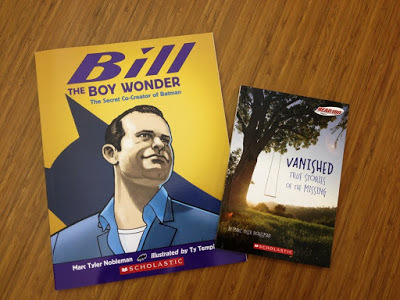 Bill with my other SBC exclusive to date, Vanished: True Stories of the Missing And now I get to quote “The hero we deserve,” the humbling 5/1/14 post on the Scholastic blog On Our Minds:
Bill with my other SBC exclusive to date, Vanished: True Stories of the Missing And now I get to quote “The hero we deserve,” the humbling 5/1/14 post on the Scholastic blog On Our Minds:
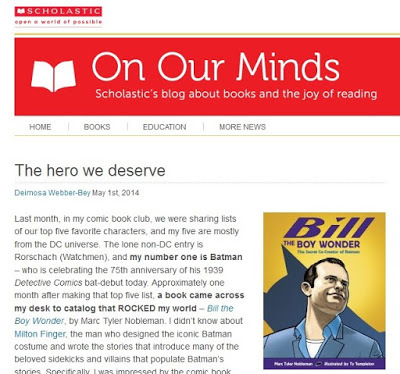
Thank you, Deimosa Webber-Bey, for writing those kind words, and thank you again, Scholastic, for publishing my words.

 Bill with my other SBC exclusive to date, Vanished: True Stories of the Missing And now I get to quote “The hero we deserve,” the humbling 5/1/14 post on the Scholastic blog On Our Minds:
Bill with my other SBC exclusive to date, Vanished: True Stories of the Missing And now I get to quote “The hero we deserve,” the humbling 5/1/14 post on the Scholastic blog On Our Minds:…a book came across my desk to catalog that ROCKED my world—Bill the Boy Wonder by Marc Tyler Nobleman. … I was impressed by the comic book style presentation of the facts in Nobleman’s book, and his use of primary sources brings a tear to the eye of this librarian! It’s a great nonfiction title to use in the classroom, considering the Common Core; there are comprehensive author’s notes and a bibliography. Seriously, though, I have to admit—I cried (beach scene, page ~35).

Thank you, Deimosa Webber-Bey, for writing those kind words, and thank you again, Scholastic, for publishing my words.
Published on July 08, 2015 04:00
July 6, 2015
Your life is nonfiction
Some kids think nonfiction is boring.
I don’t blame them. Some adults think so, too, and some nonfiction is boring. Then again, so is some fiction. So why do kids more commonly dismiss nonfiction?
At least part of the reason is that children’s nonfiction was often written without regard for prose. But starting a book with the date and place of a notable figure’s birth is, in most cases, a thing of the past (historically and literarily). Now some readers don’t give writers (nonfiction or fiction) till the end of the first page to engage us. We don’t even give them to the end of the first paragraph. We expect to be grabbed by the first sentence.
We are strict. Or we should be.
Modern readers want writers of any kind of book or article to wow us not only with complex characters and a propulsive plot but also with lyrical language. As I have written here before, it’s not enough to have a good story; you need a good story, well told. (Source: my college film theory professor Tom Doherty.) Nonfiction, like life, is more interesting when it’s nonlinear and unpredictable. Yes, that makes it messier, but messy makes for better drama. Messy is not boring.
Fact-after-fact nonfiction: out.
Narrative nonfiction: in.
So when kids tell me that nonfiction is boring, I ask them what they do first thing Monday morning, in school but before class starts. They all say the same thing: we talk to our friends. I ask about what. They all say the same thing: what we did over the weekend. Then I always say the same thing.
That’s nonfiction.
What you do is a true story. Your life is nonfiction. And if you’re talking about it, you must like nonfiction more than you think you do.
The unpredictable (yet welcome) thing about that is that they see that they agree.
I don’t blame them. Some adults think so, too, and some nonfiction is boring. Then again, so is some fiction. So why do kids more commonly dismiss nonfiction?
At least part of the reason is that children’s nonfiction was often written without regard for prose. But starting a book with the date and place of a notable figure’s birth is, in most cases, a thing of the past (historically and literarily). Now some readers don’t give writers (nonfiction or fiction) till the end of the first page to engage us. We don’t even give them to the end of the first paragraph. We expect to be grabbed by the first sentence.
We are strict. Or we should be.
Modern readers want writers of any kind of book or article to wow us not only with complex characters and a propulsive plot but also with lyrical language. As I have written here before, it’s not enough to have a good story; you need a good story, well told. (Source: my college film theory professor Tom Doherty.) Nonfiction, like life, is more interesting when it’s nonlinear and unpredictable. Yes, that makes it messier, but messy makes for better drama. Messy is not boring.
Fact-after-fact nonfiction: out.
Narrative nonfiction: in.
So when kids tell me that nonfiction is boring, I ask them what they do first thing Monday morning, in school but before class starts. They all say the same thing: we talk to our friends. I ask about what. They all say the same thing: what we did over the weekend. Then I always say the same thing.
That’s nonfiction.
What you do is a true story. Your life is nonfiction. And if you’re talking about it, you must like nonfiction more than you think you do.
The unpredictable (yet welcome) thing about that is that they see that they agree.
Published on July 06, 2015 04:00
July 2, 2015
Monsoon, Gandhi’s final walk, and the Taj Mahal
In January 2015, I spent two eye-opening weeks speaking at the American School of Bombay, my first time in India. I was fortunate to be invited back to teach creative writing during summer break (what they call intersession), bringing my total number of 2015 weeks in India to five.
The school divides their intersession offerings into three buckets: Body, Mind, and Soul. I was curious—and not in disagreement—to see that they put my program (“Thrills, Chills, and Spills: The Adventure of Creative Writing”) under Soul.
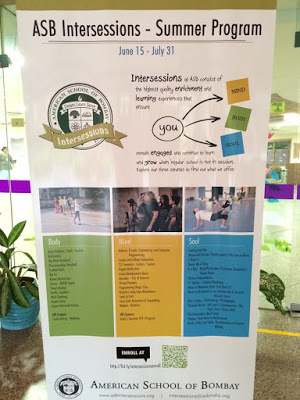
Last time, I was only in Mumbai (including a boat trip to Elephanta Island), a city so historic and vast that it felt like I’d explored a lot more area than I physically did. This time, I was exposed to three additional aspects of India: monsoon season, Delhi, and the Taj Mahal.
I arrived in Mumbai on 6/13/15, during a brief spell of not rain. But then for almost the next two weeks, the rain was daily, often all day, and often heavy.
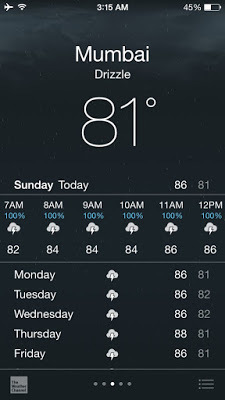
On June 19, all school activities were canceled due to the monsoon. For some reason, I saw that as a good opportunity to venture out on foot.
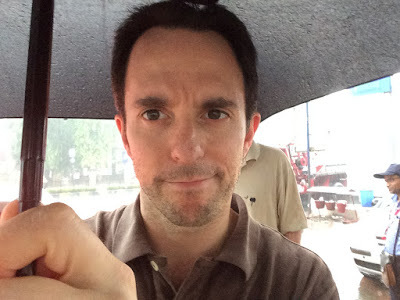
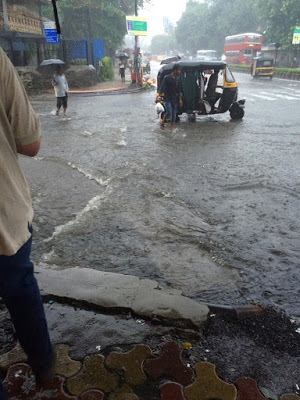
I walked 15 minutes and back (with umbrella), returning looking like I’d swum laps in my clothes.
It turned out to be Mumbai’s wettest June day since 2005.
As before, I found Mumbai to be a nonstop barrage of stimuli, some lovely but the majority a difficult reminder of the struggle so many go through daily just to get clean water, food, and shelter.
To help people get out of the slums and off the streets, the Indian government erects residential buildings. Through a lottery, families are selected to move into a new apartment, free of charge. However, some don’t move in; instead they sell it or rent it out. Money trumps comfort.
On June 27, I flew to Delhi (the flight is just under two hours). There I visited several sites including...
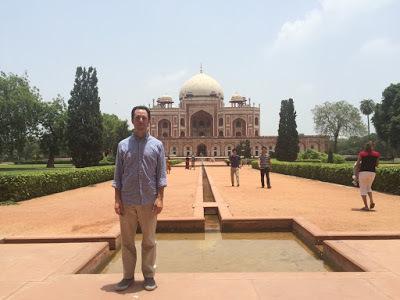 ...Humayun’s Tomb (sometimes described as an inspiration for the larger and more well-known Taj Mahal)...
...Humayun’s Tomb (sometimes described as an inspiration for the larger and more well-known Taj Mahal)...
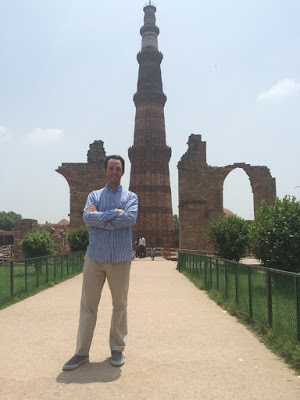 ...and Qutb Minar (the world’s tallest brick minaret, a category I did not know existed).
...and Qutb Minar (the world’s tallest brick minaret, a category I did not know existed).
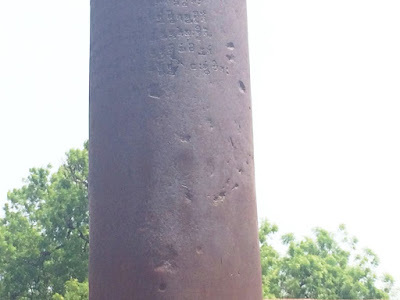 The writing on this pillar on the expansive grounds of Qutb Minar is inscribed with a language whose meaning has been lost.
The writing on this pillar on the expansive grounds of Qutb Minar is inscribed with a language whose meaning has been lost.
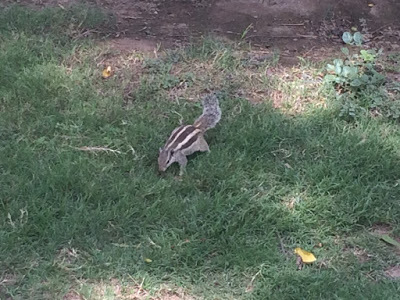 In India, squirrels look like chipmunks.
In India, squirrels look like chipmunks.
The most moving stop in Delhi (if not all of India) was Gandhi Smriti, the site of Gandhi’s 1948 assassination. It was all the more emotional because in a city of 11 million, I was practically alone there.
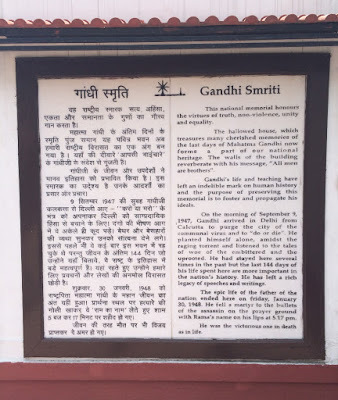
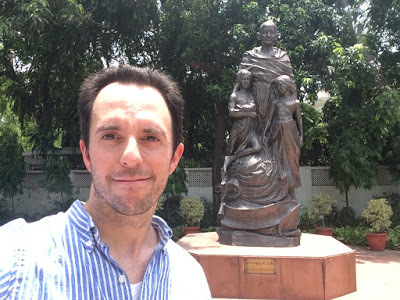
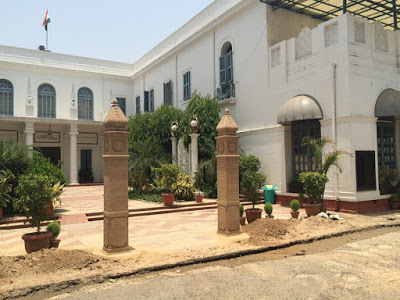
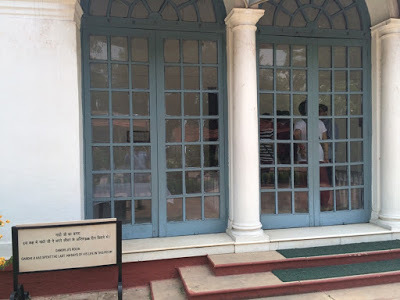
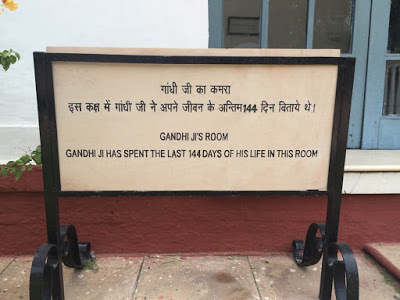
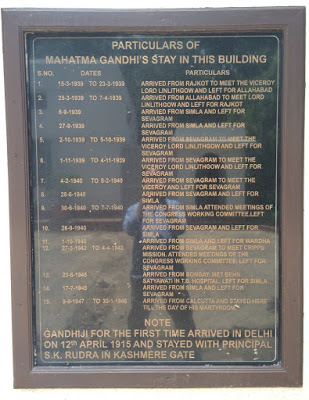
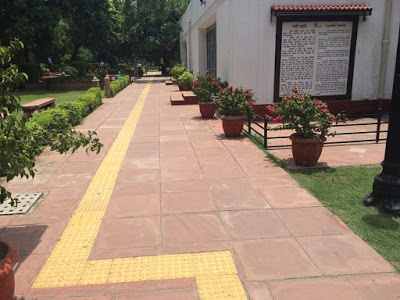 Visitors follow this yellow line to reach the spot where Gandhi was fatally shot.
Visitors follow this yellow line to reach the spot where Gandhi was fatally shot.

When you force yourself to temporarily forget what happened there,the serene beauty of the place envelops you.
Gandhi himself took a different route, hauntingly marked as shown.
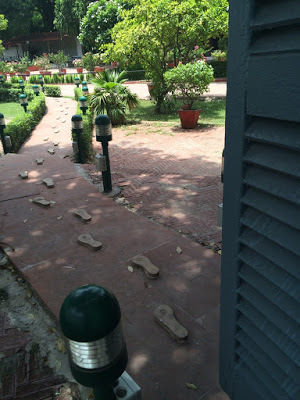
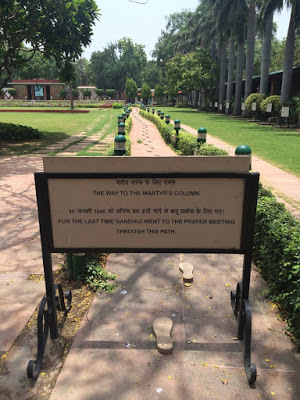
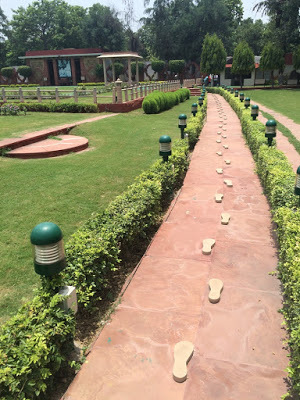
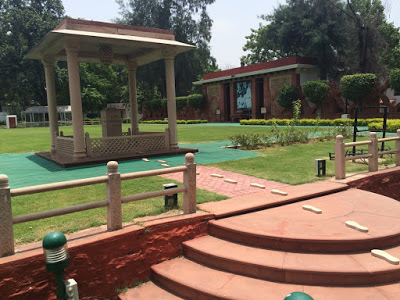
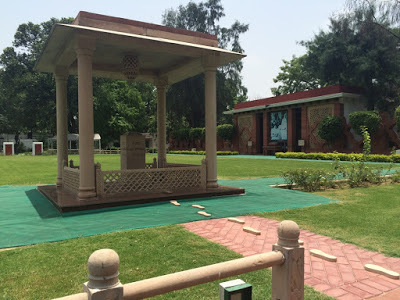
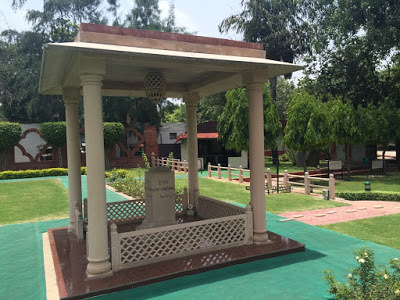
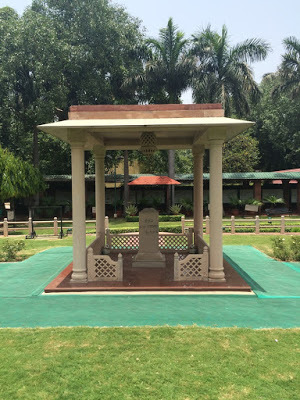
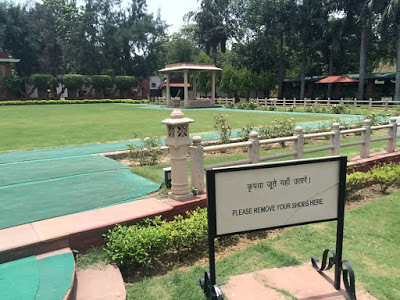
Footsteps worth following.
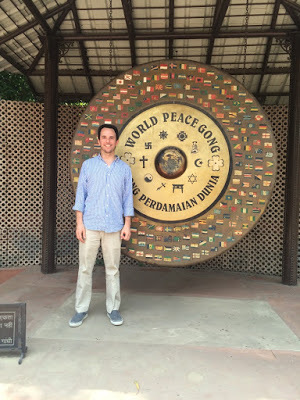
From Delhi, I set out by car to Agra, the city home to the jewel of India and a Wonder of the World, the Taj Mahal. The tour company who packaged the weekend for me (highly recommended: Elephanta Tours) said the drive would take 4.5 hours. Both there and back, we did it closer to three. My driver was another jewel of India—a very kind man. He witnessed firsthand one of the 2008 bombings in Mumbai; the people in his building were forced to stay there for four days.
Agra from the car:
Also spotted upon entering Agra:
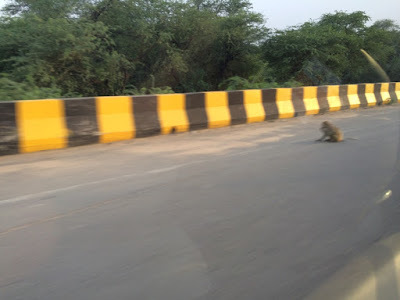 monkey on the highway
monkey on the highway
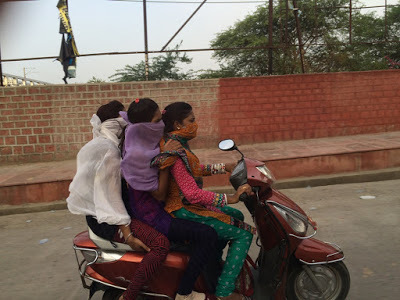
three vibrantly dressed women on a motorcycle
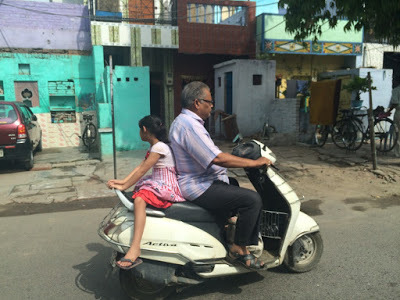
the official image of “This Is Not America”
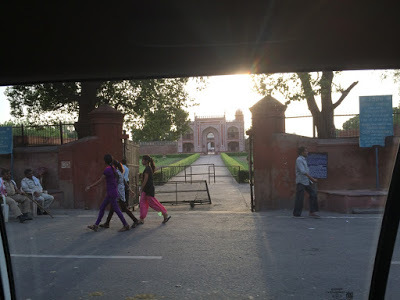 the tomb of I’timād-ud-Daulah, which the driver referred to as the “Baby Taj” and which has been described as “a draft of the Taj Mahal” (Wikipedia)
the tomb of I’timād-ud-Daulah, which the driver referred to as the “Baby Taj” and which has been described as “a draft of the Taj Mahal” (Wikipedia)
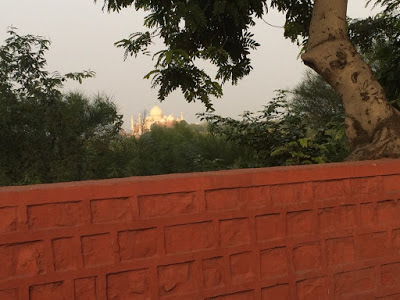
my first glimpse of the Taj Mahal, from the moving car
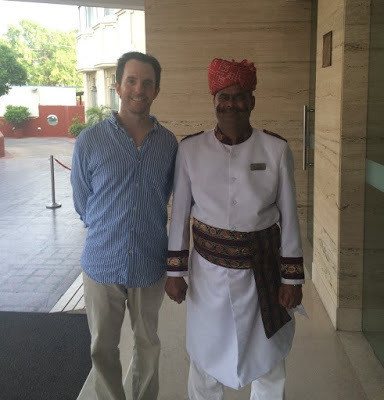
the doorman (right) at the Hotel Howard Plaza in Agra

my comfortable room at the hotel
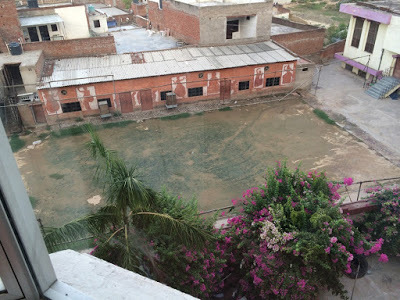
the view from my hotel room; I particularly liked the figures painted on the nearest red-brick building
To beat the crowds (and the 100-degree heat), I left at 5 a.m. to see the Taj, which was less than five minutes from my hotel. When the Taj first comes into view, it is ghostly.
It was sparsely attended for the first 30 or so minutes, then the traffic picked up, but it’s off-season so it was never packed. It felt like I stayed there most of the day so when I left I was shocked to see that it was only 7:15 a.m.
The Taj sits on the Yamuna River, and a story goes that on the opposite side, a Black Taj was to be built. It seems this is most likely a myth—but if there is a way to make the Taj Mahal even more intriguing, that is it.
My guide said the Taj was built to withstand an earthquake and could weather one as strong as 8.5; the minarets tilt slightly out so if they were to topple, they would not hit the Taj itself.
The administrators of the Taj allow film production on the grounds, but not with sound effects—nothing to risk damaging the structure.
Only a week before my visit, the Taj installed free wifi. A key moment in its timeline? Hardly, but still felt historic. And I’m proud to say I didn’t log in; some selfies should not be shared in the moment. But now is okay:
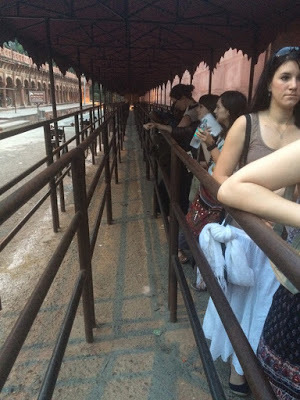 long runway to line up
long runway to line up
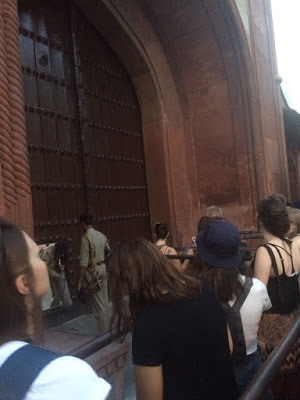 the entrance to the entrance (but first, security)
the entrance to the entrance (but first, security)
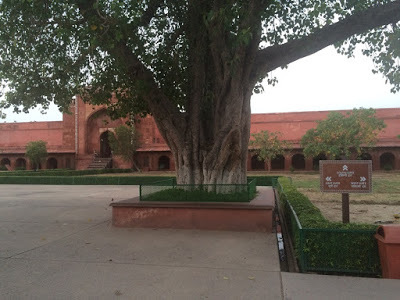 sign for the three entrance gates
sign for the three entrance gates
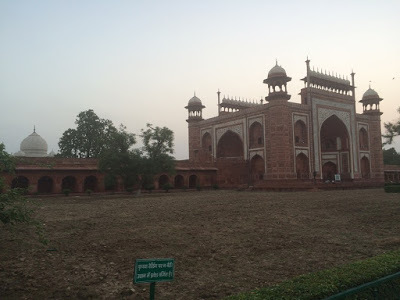 west gate, which is the main entrance; you can see the top of the Taj
west gate, which is the main entrance; you can see the top of the Taj
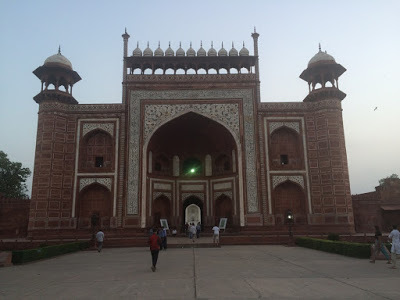
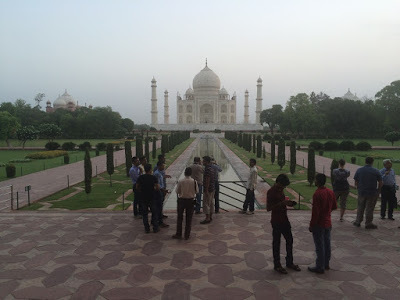 To quote Lonely Planet, “Its raised position means that the backdrop is only sky—a masterstroke of design.”
To quote Lonely Planet, “Its raised position means that the backdrop is only sky—a masterstroke of design.”
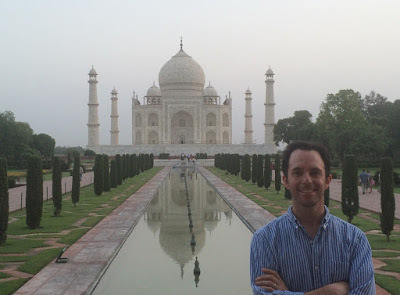
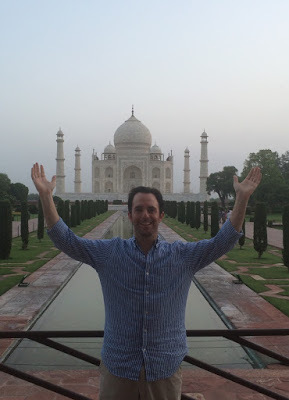
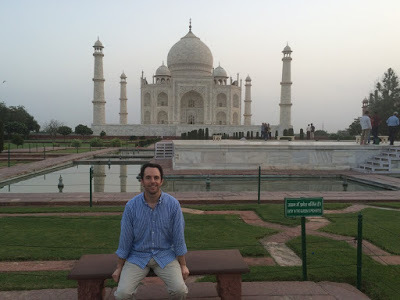
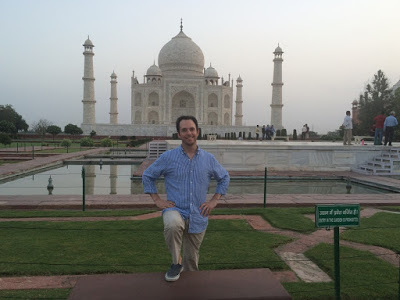 My guide directed me to do this pose.
My guide directed me to do this pose.
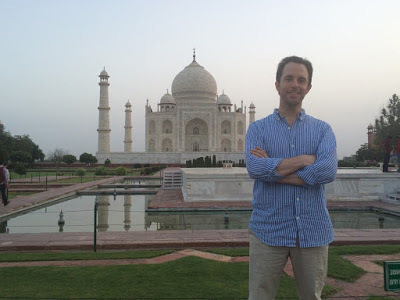
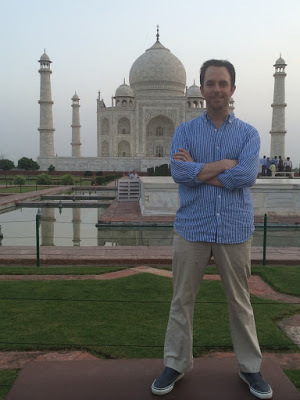
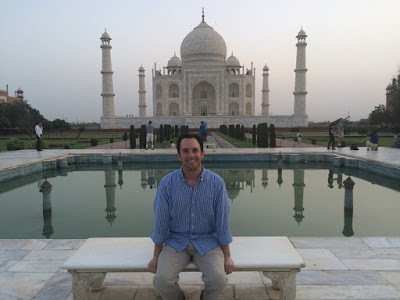 This bench has supported the rears of many world leaders and celebrities including Bill Clinton, Oprah Winfrey, Julia Roberts, and Katy Perry. (Full disclosure: though all of them have visited the Taj, and thought this bench does offer perhaps the best view of a person and the Taj, I can’t say with
This bench has supported the rears of many world leaders and celebrities including Bill Clinton, Oprah Winfrey, Julia Roberts, and Katy Perry. (Full disclosure: though all of them have visited the Taj, and thought this bench does offer perhaps the best view of a person and the Taj, I can’t say with
100% certainty that all of them did indeed pose there. But it seems a safe bet.)
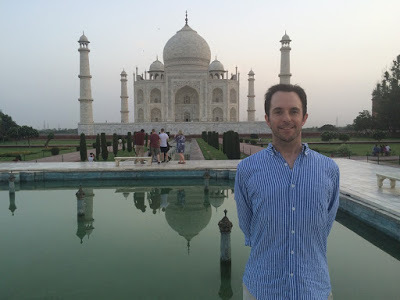 minaret head
minaret head
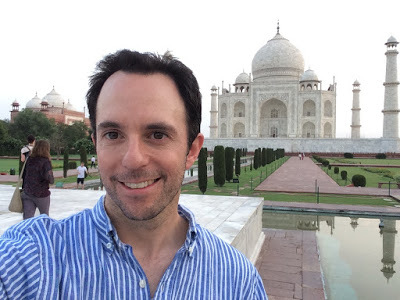
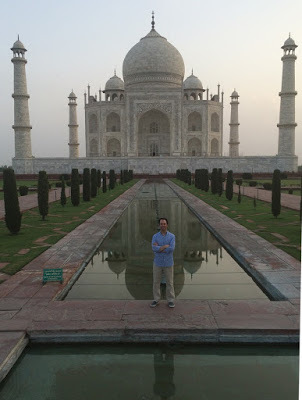 Blows my minaret head that this makes it looklike I was the only person there.
Blows my minaret head that this makes it looklike I was the only person there.
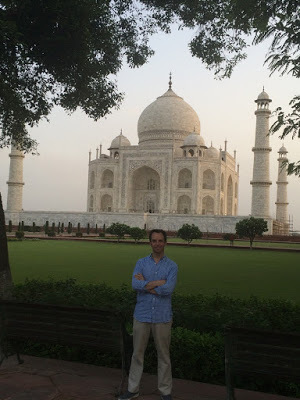
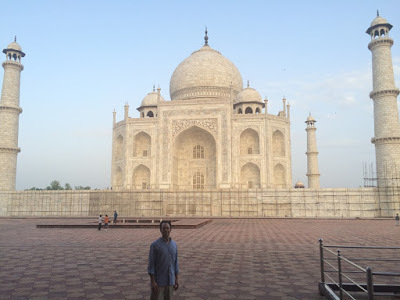
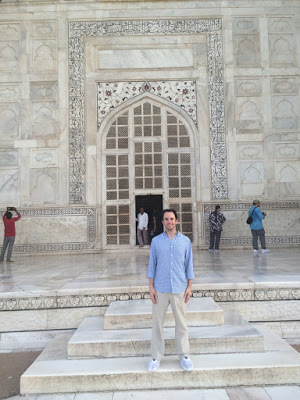 Note stylish shoe covers. (Actually, somewould say they were more stylish than the shoes I wore.)
Note stylish shoe covers. (Actually, somewould say they were more stylish than the shoes I wore.)
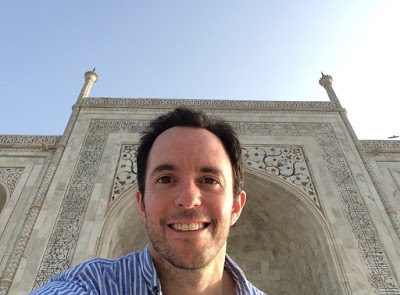 Spot the hawk.
Spot the hawk.
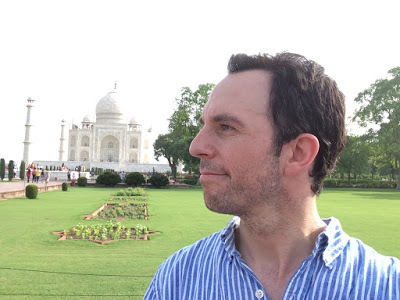
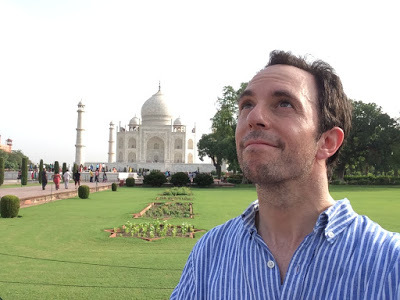
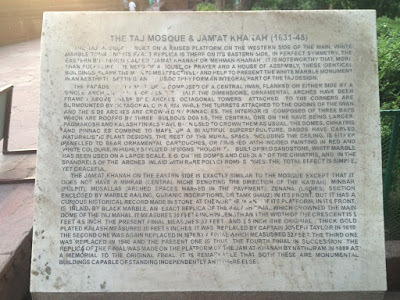
 panorama from the entrance gate
panorama from the entrance gate
 sunrise panorama from the side of the tomb
sunrise panorama from the side of the tomb

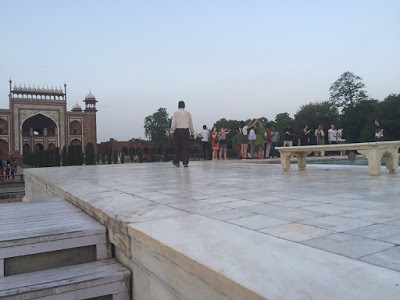 Look closely and you can see visitors posing for a photo in one of the typical ways, with arms forming a tent over the dome.
Look closely and you can see visitors posing for a photo in one of the typical ways, with arms forming a tent over the dome.
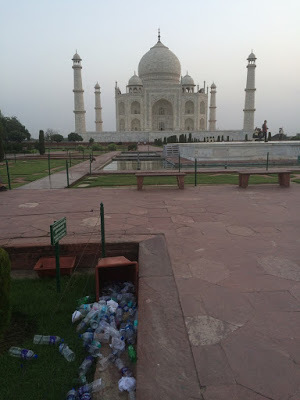 No food and only water bottles are allowed in.Unfortunately, I saw more than a few water bottlesnot in trash cans.
No food and only water bottles are allowed in.Unfortunately, I saw more than a few water bottlesnot in trash cans.
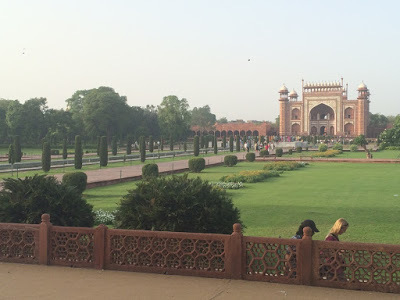 View of the main gate from the Taj.
View of the main gate from the Taj.
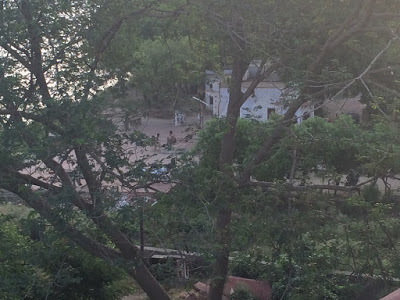 Guards along the river behind the Taj. Closer up, guards and cameras prevent people from chipping off a piece of the building, among other more obvious infractions.
Guards along the river behind the Taj. Closer up, guards and cameras prevent people from chipping off a piece of the building, among other more obvious infractions.
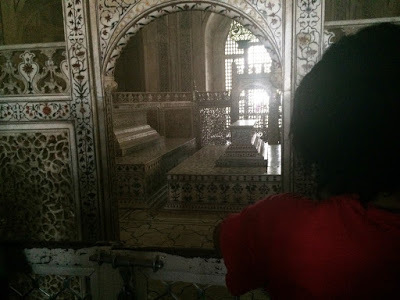 The only aspect of the Taj that is not symmetrical are the two (replica) tombs: one for Mumtaz Mahal, the wife of Mughal emperor Shah Jahan
The only aspect of the Taj that is not symmetrical are the two (replica) tombs: one for Mumtaz Mahal, the wife of Mughal emperor Shah Jahan
(reigned 1628–1658), who in his grief had the Taj built in her honor; the other added later for the emperor himself. (It should be noted that Mumtaz Mahal was one of three wives,
but his favorite. Obvs.)
 Joined hearts. I was surprised that this symbol was used forlove a) in India and b) back then.
Joined hearts. I was surprised that this symbol was used forlove a) in India and b) back then.
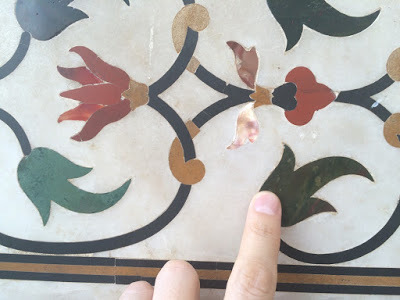 detail 1
detail 1
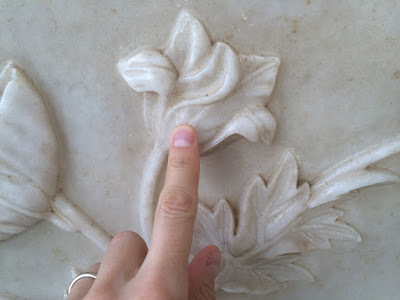 detail 2
detail 2
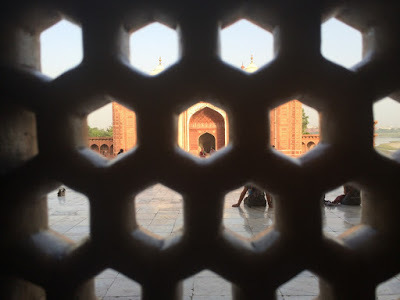
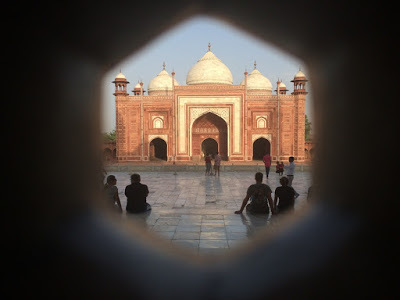
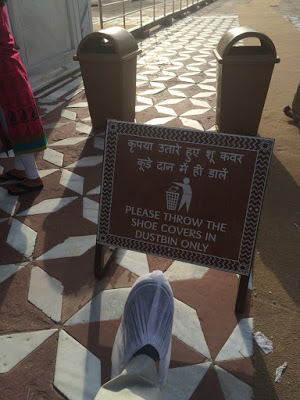
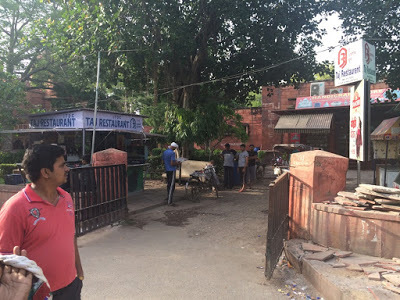 the first food stand outside the Taj
the first food stand outside the Taj
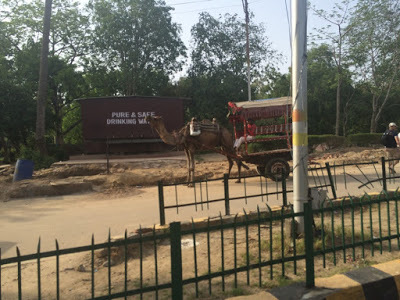 camel
camel
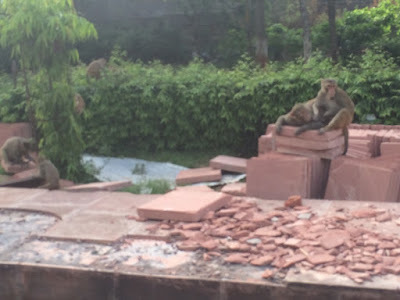 more monkeys
more monkeys
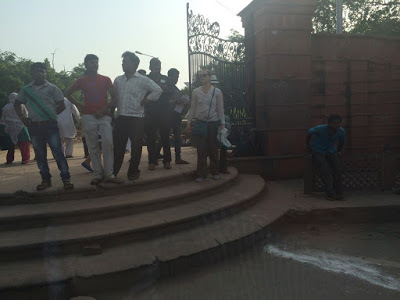 the entrance to the entrance to the Taj...small and modest
the entrance to the entrance to the Taj...small and modest
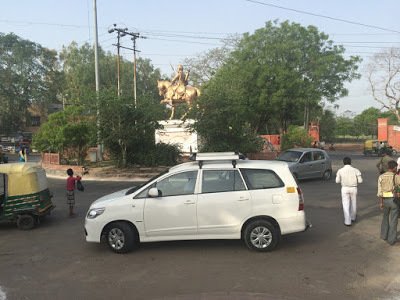 You can be picked up right in front. No vast parking lot.
You can be picked up right in front. No vast parking lot.
No parking lot period.
Weirdly, the Taj reminded me of the monster in the movie Cloverfield—a large thing in distance you feel you can never get close to (though in the Taj’s case, you want to).
And you can.
After I went through the Taj once, I returned to the entrance gate, turned around, and repeated the walk to shoot a time-lapse film of the experience.
Time it took me from the main gate of the Taj Mahal grounds to the Taj itself, where you cannot enter directly (traffic is directed all the way around the back, ending up on its front step, from which you can turn around and see the main gate): about 7 minutes.
Here’s the trip in 20 seconds (watch in HD):
As you can see, the Taj is breathtaking from any angle. More than any other place I’ve been in recent memory, it makes me want to travel to the past.
The total for this one-night trip to Delhi and Agra (all-inclusive except for the cab to/from the Mumbai airport, my lunches, and tips for my guides) was 31,536 rupees—less than $500.
In closing, pickles. If traveling to India, don’t leave home with them.
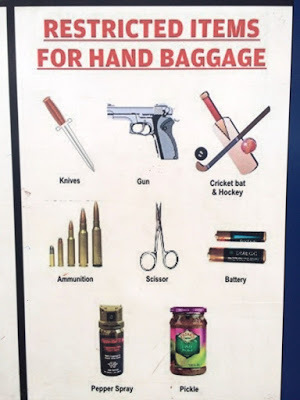
The school divides their intersession offerings into three buckets: Body, Mind, and Soul. I was curious—and not in disagreement—to see that they put my program (“Thrills, Chills, and Spills: The Adventure of Creative Writing”) under Soul.

Last time, I was only in Mumbai (including a boat trip to Elephanta Island), a city so historic and vast that it felt like I’d explored a lot more area than I physically did. This time, I was exposed to three additional aspects of India: monsoon season, Delhi, and the Taj Mahal.
I arrived in Mumbai on 6/13/15, during a brief spell of not rain. But then for almost the next two weeks, the rain was daily, often all day, and often heavy.

On June 19, all school activities were canceled due to the monsoon. For some reason, I saw that as a good opportunity to venture out on foot.


I walked 15 minutes and back (with umbrella), returning looking like I’d swum laps in my clothes.
It turned out to be Mumbai’s wettest June day since 2005.
As before, I found Mumbai to be a nonstop barrage of stimuli, some lovely but the majority a difficult reminder of the struggle so many go through daily just to get clean water, food, and shelter.
To help people get out of the slums and off the streets, the Indian government erects residential buildings. Through a lottery, families are selected to move into a new apartment, free of charge. However, some don’t move in; instead they sell it or rent it out. Money trumps comfort.
On June 27, I flew to Delhi (the flight is just under two hours). There I visited several sites including...
 ...Humayun’s Tomb (sometimes described as an inspiration for the larger and more well-known Taj Mahal)...
...Humayun’s Tomb (sometimes described as an inspiration for the larger and more well-known Taj Mahal)... ...and Qutb Minar (the world’s tallest brick minaret, a category I did not know existed).
...and Qutb Minar (the world’s tallest brick minaret, a category I did not know existed). The writing on this pillar on the expansive grounds of Qutb Minar is inscribed with a language whose meaning has been lost.
The writing on this pillar on the expansive grounds of Qutb Minar is inscribed with a language whose meaning has been lost. In India, squirrels look like chipmunks.
In India, squirrels look like chipmunks.The most moving stop in Delhi (if not all of India) was Gandhi Smriti, the site of Gandhi’s 1948 assassination. It was all the more emotional because in a city of 11 million, I was practically alone there.






 Visitors follow this yellow line to reach the spot where Gandhi was fatally shot.
Visitors follow this yellow line to reach the spot where Gandhi was fatally shot.
When you force yourself to temporarily forget what happened there,the serene beauty of the place envelops you.
Gandhi himself took a different route, hauntingly marked as shown.








Footsteps worth following.

From Delhi, I set out by car to Agra, the city home to the jewel of India and a Wonder of the World, the Taj Mahal. The tour company who packaged the weekend for me (highly recommended: Elephanta Tours) said the drive would take 4.5 hours. Both there and back, we did it closer to three. My driver was another jewel of India—a very kind man. He witnessed firsthand one of the 2008 bombings in Mumbai; the people in his building were forced to stay there for four days.
Agra from the car:
Also spotted upon entering Agra:
 monkey on the highway
monkey on the highway
three vibrantly dressed women on a motorcycle

the official image of “This Is Not America”
 the tomb of I’timād-ud-Daulah, which the driver referred to as the “Baby Taj” and which has been described as “a draft of the Taj Mahal” (Wikipedia)
the tomb of I’timād-ud-Daulah, which the driver referred to as the “Baby Taj” and which has been described as “a draft of the Taj Mahal” (Wikipedia)
my first glimpse of the Taj Mahal, from the moving car

the doorman (right) at the Hotel Howard Plaza in Agra

my comfortable room at the hotel

the view from my hotel room; I particularly liked the figures painted on the nearest red-brick building
To beat the crowds (and the 100-degree heat), I left at 5 a.m. to see the Taj, which was less than five minutes from my hotel. When the Taj first comes into view, it is ghostly.
It was sparsely attended for the first 30 or so minutes, then the traffic picked up, but it’s off-season so it was never packed. It felt like I stayed there most of the day so when I left I was shocked to see that it was only 7:15 a.m.
The Taj sits on the Yamuna River, and a story goes that on the opposite side, a Black Taj was to be built. It seems this is most likely a myth—but if there is a way to make the Taj Mahal even more intriguing, that is it.
My guide said the Taj was built to withstand an earthquake and could weather one as strong as 8.5; the minarets tilt slightly out so if they were to topple, they would not hit the Taj itself.
The administrators of the Taj allow film production on the grounds, but not with sound effects—nothing to risk damaging the structure.
Only a week before my visit, the Taj installed free wifi. A key moment in its timeline? Hardly, but still felt historic. And I’m proud to say I didn’t log in; some selfies should not be shared in the moment. But now is okay:
 long runway to line up
long runway to line up the entrance to the entrance (but first, security)
the entrance to the entrance (but first, security) sign for the three entrance gates
sign for the three entrance gates west gate, which is the main entrance; you can see the top of the Taj
west gate, which is the main entrance; you can see the top of the Taj
 To quote Lonely Planet, “Its raised position means that the backdrop is only sky—a masterstroke of design.”
To quote Lonely Planet, “Its raised position means that the backdrop is only sky—a masterstroke of design.”


 My guide directed me to do this pose.
My guide directed me to do this pose.

 This bench has supported the rears of many world leaders and celebrities including Bill Clinton, Oprah Winfrey, Julia Roberts, and Katy Perry. (Full disclosure: though all of them have visited the Taj, and thought this bench does offer perhaps the best view of a person and the Taj, I can’t say with
This bench has supported the rears of many world leaders and celebrities including Bill Clinton, Oprah Winfrey, Julia Roberts, and Katy Perry. (Full disclosure: though all of them have visited the Taj, and thought this bench does offer perhaps the best view of a person and the Taj, I can’t say with 100% certainty that all of them did indeed pose there. But it seems a safe bet.)
 minaret head
minaret head
 Blows my minaret head that this makes it looklike I was the only person there.
Blows my minaret head that this makes it looklike I was the only person there.

 Note stylish shoe covers. (Actually, somewould say they were more stylish than the shoes I wore.)
Note stylish shoe covers. (Actually, somewould say they were more stylish than the shoes I wore.) Spot the hawk.
Spot the hawk.


 panorama from the entrance gate
panorama from the entrance gate sunrise panorama from the side of the tomb
sunrise panorama from the side of the tomb 
 Look closely and you can see visitors posing for a photo in one of the typical ways, with arms forming a tent over the dome.
Look closely and you can see visitors posing for a photo in one of the typical ways, with arms forming a tent over the dome. No food and only water bottles are allowed in.Unfortunately, I saw more than a few water bottlesnot in trash cans.
No food and only water bottles are allowed in.Unfortunately, I saw more than a few water bottlesnot in trash cans. View of the main gate from the Taj.
View of the main gate from the Taj. Guards along the river behind the Taj. Closer up, guards and cameras prevent people from chipping off a piece of the building, among other more obvious infractions.
Guards along the river behind the Taj. Closer up, guards and cameras prevent people from chipping off a piece of the building, among other more obvious infractions. The only aspect of the Taj that is not symmetrical are the two (replica) tombs: one for Mumtaz Mahal, the wife of Mughal emperor Shah Jahan
The only aspect of the Taj that is not symmetrical are the two (replica) tombs: one for Mumtaz Mahal, the wife of Mughal emperor Shah Jahan (reigned 1628–1658), who in his grief had the Taj built in her honor; the other added later for the emperor himself. (It should be noted that Mumtaz Mahal was one of three wives,
but his favorite. Obvs.)
 Joined hearts. I was surprised that this symbol was used forlove a) in India and b) back then.
Joined hearts. I was surprised that this symbol was used forlove a) in India and b) back then. detail 1
detail 1 detail 2
detail 2


 the first food stand outside the Taj
the first food stand outside the Taj camel
camel more monkeys
more monkeys the entrance to the entrance to the Taj...small and modest
the entrance to the entrance to the Taj...small and modest You can be picked up right in front. No vast parking lot.
You can be picked up right in front. No vast parking lot. No parking lot period.
Weirdly, the Taj reminded me of the monster in the movie Cloverfield—a large thing in distance you feel you can never get close to (though in the Taj’s case, you want to).
And you can.
After I went through the Taj once, I returned to the entrance gate, turned around, and repeated the walk to shoot a time-lapse film of the experience.
Time it took me from the main gate of the Taj Mahal grounds to the Taj itself, where you cannot enter directly (traffic is directed all the way around the back, ending up on its front step, from which you can turn around and see the main gate): about 7 minutes.
Here’s the trip in 20 seconds (watch in HD):
As you can see, the Taj is breathtaking from any angle. More than any other place I’ve been in recent memory, it makes me want to travel to the past.
The total for this one-night trip to Delhi and Agra (all-inclusive except for the cab to/from the Mumbai airport, my lunches, and tips for my guides) was 31,536 rupees—less than $500.
In closing, pickles. If traveling to India, don’t leave home with them.

Published on July 02, 2015 04:00
June 29, 2015
The first cosplay of Bob Kane’s Batman
Thank you to Joe Littrell of Florida’s Coliseum of Comics for tweeting me about Phil Boyle’s photograph of Patrick Hawkins’s cosplay of Bob Kane’s original concept for Batman.
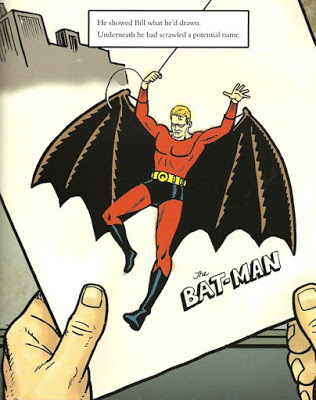 art by Ty Templeton, from Bill the Boy Wonder:
art by Ty Templeton, from Bill the Boy Wonder:
The Secret Co-Creator of Batman
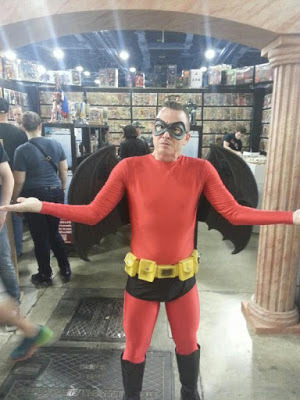
This may be a first. Either way, this definitely is the coolest thing I’ve seen in a while...and yesterday I saw the Taj Mahal.
 art by Ty Templeton, from Bill the Boy Wonder:
art by Ty Templeton, from Bill the Boy Wonder:The Secret Co-Creator of Batman

This may be a first. Either way, this definitely is the coolest thing I’ve seen in a while...and yesterday I saw the Taj Mahal.
Published on June 29, 2015 11:13



